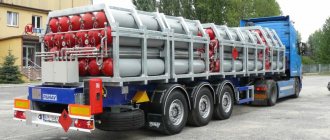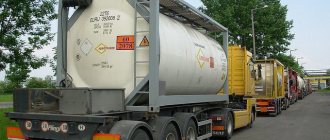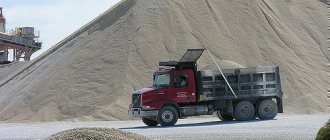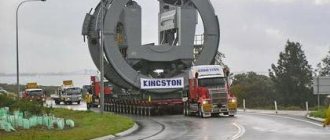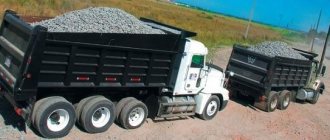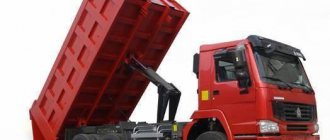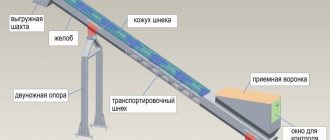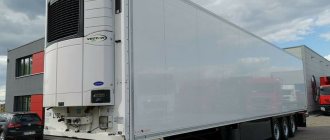Transportation of cylinders containing compressed air or liquefied gas, according to legislation, is a dangerous transported cargo. Transportation of oxygen cylinders requires compliance with all prescribed requirements.
First of all, this is due to the placement and securing of dangerous cargo. The transport on which oxygen will be transported must also have all the necessary equipment.
Basic regulations
"ADR", or ADR, is the fundamental document regulating the transport of oxygen cylinders. In fact, this is an international treaty that regulates the rules throughout Europe. Other equally important regulations include:
- general rules for the transportation of road cargo, approved in 2011 by Government Decree No. 272;
- rules for the transportation of dangerous goods across the country No. 73, approved by order in 1995 (with amendments and additions);
- the manual of the Department of Motor Transport of Russia, adopted back in 1996 under No. 3112199-099096;
- rules for compliance with safety measures prescribed in Decree No. 372 dated April 23, 1994.
Additional measures for the transport of oxygen cylinders are covered in the Ministry of Transport Regulation No. 47 of 1994.
Primary requirements
Under no circumstances should oxygen cylinders be loaded while the car engine is running. Shaking containers or careless handling or handling is unacceptable.
When transporting multiple cylinders:
- they should all be laid in one direction with valves;
- for fastening it is permissible to use only special tapes;
- Any movement of the cylinders while the vehicle is moving should be prevented.
In cases where the diameter of the cylinders exceeds 30 cm, they will have to be laid along the longitudinal axis of the body. All of them must have rotary safety valves. It is mandatory that all cylinders in the trailer or body are laid out so that the valves are away from the driver’s cab.
Transport hazard classes
State standard 19433-88 identifies 9 classes of substances based on the degree of their danger during transportation:
- explosive materials;
- compressed gases;
- flammable liquid substances;
- solid self-igniting and flammable substances;
- substances with sufficient oxidizability and peroxides;
- cargo with toxic and infectious substances;
- radioactive substances;
- caustic cargo and corrosive substances;
- other substances with increased danger.
Rules for the transportation of gas cylinders by road The legislator identifies the following rules according to which the transportation of gas cylinders by road for a private individual is carried out:
- cylinders are located only in a horizontal position;
- located in the body of the vehicle;
- containers must ensure that depressurization is inadmissible;
- the cylinders are separated from each other by gaskets;
- The vehicle must have fire extinguishers - carbon dioxide and powder (minimum 2 liters each).
Rules for transporting gas cylinders by car
In accordance with traffic regulations:
- cylinders must be in full working order;
- equipped with danger signs and necessary protective equipment;
- cannot exceed the specified filling volume;
- must be secured in accordance with the rules (to prevent impacts, movements - sockets, fastenings);
- transportation is carried out only in the trunk;
- carry out leak tests;
- the cargo is transported horizontally, in compliance with safety rules and taking into account road conditions.
Transporting oxygen in an unequipped vehicle
The rules stipulate that the transportation of gas cylinders with oxygen on unequipped transport is carried out under the following conditions:
- no more than 4 cylinders are transported at a time;
- located in special equipment (fenced, with gaskets between them);
- valves are laid in one direction.
Marking
The main thing to consider is that the cylinder should be colored depending not on the name of the gas, but on how dangerous it is. According to the international classification for oxygen, cylinders are painted white (RAL 9010). At the same time, in our country you can find oxygen cylinders painted blue (RAL 5012), which means oxidizing.
Each cylinder must bear the mark 5.1 or 2.2, which marks oxidizing substances. Such cargo belongs to hazard class 2 as a non-toxic, oxidizing and non-flammable gas.
Important points
Transportation of gas and oxygen cylinders is impossible without a high level of competence in organizing such processes. Responsibility for transportation lies with both the driver and the transport company. It is fully regulated simultaneously by several legislative acts and sets of carefully developed rules for the transportation of containers.
Important! Oxygen must be transported on vehicles and strictly in the form of containers placed on the bottom of the body. Each is covered with gaskets.
Wood blocks are used as spacers, where nests are pre-cut that fully correspond to the dimensions of the transported cylinder. At the same time, drivers and employees of transport companies must use special rings made of high-quality rubber for each container. Their thickness must be at least 25 mm. Put two rings on one container. All of this will help prevent the oxygen from hitting each other.
Speed and other restrictions
Transportation of oxygen cylinders is permissible only at vehicle speeds of up to 60 km/h. If weather conditions are unfavorable (rain, snow, hail, fog, etc.), then the speed should be reduced even more.
When transporting cylinders in the summer, they must be protected from sunlight. This can be a special film or an ordinary tarpaulin.
For those who are interested in how to transport oxygen cylinders together with passengers, we immediately say: in no case should you transport people and cylinders together, regardless of the time of year, weather conditions and vehicle speed.
Simplified procedure
In some cases, it is allowed that a truck does not meet all the requirements of ADR. We are talking about situations where the total degree in one cylinder and several will not exceed 20. The same rule applies to passenger vehicles.
We are talking not only about degrees, but also about volume, the maximum size of which is 1,000 liters. In this case, there is also no need to apply special markings or obtain an ADR certificate or other permits.
Rules for safe handling of propane cylinders during transportation
Loading propane cylinders
Persons involved in loading may only handle cylinders with clean hands. To avoid the cylinder slipping, it is recommended to use clean gloves or a rag. This will prevent sand or grease from contaminating the valve nozzle. It is better to move cylinders from the warehouse to the car using carts designed for this purpose. Propane cylinders must not be dragged. When loading gas containers using lifting mechanisms, care should be taken to securely secure the cylinders to avoid falling.
In the case of propane transportation, negligence is punished especially severely! Here we are not talking about fines or banal loss of cargo, which entailed only financial losses. The consequences of ignoring safety rules can lead to a real emergency.
Safety measures for personnel
The rules for transporting oxygen cylinders by road provide special requirements for the personnel who transport and load them:
- Both categories of employees must complete a training course in health and safety.
- Drivers are required to undergo training in knowledge of the rules for transporting hazardous substances and confirm their knowledge with a certificate.
- Workers must prevent the risk of explosion.
- The driver must ensure that a spark arrester is installed on the vehicle's exhaust pipe.
- In summer, cylinders on the car should be protected from sunlight by a tarpaulin.
- You cannot throw cylinders.
- A closed vehicle must have a ventilation system.
- Smoking near the cylinders, opening them, or breaking the seal is not allowed.
A truck intended for the transport of dangerous goods must have fire extinguishing equipment: carbon dioxide and powder fire extinguishers with a volume of at least 2 liters each.
I. General provisions.
1.1. This instruction defines the basic requirements for the operation, storage and transportation of oxygen cylinders used at the enterprise.
1.2. The instructions were compiled on the basis of the requirements of the “Rules for the design and safe operation of pressure vessels”, approved on October 18, 1994, by the Gosnadzorohrantruda Committee, “Rules for the transportation by road of inert gases and oxygen, compressed and liquid”, as well as other regulatory documents.
1.3. The requirements of these instructions apply to cylinders with a capacity of 40 liters intended for storing and transporting oxygen.
1.4. Work related to the operation, transportation and storage of oxygen cylinders is permitted to persons at least 18 years of age who have undergone a medical examination, special training, passed a knowledge test in the scope of these instructions and have an appropriate entry in the knowledge test certificate.
1.5. Periodic testing of the knowledge of personnel involved in the operation and storage of oxygen cylinders is carried out at least once a year.
1.6. An extraordinary knowledge test is carried out in the event of changes in the requirements of this instruction, their violation, at the request of representatives of the State Supervision Authority for Labor Supervision or persons responsible for supervising the technical condition and operation of cylinders assigned in each division of the enterprise from among the engineering and technical personnel.
1.7. Personnel involved in work related to the operation and storage of oxygen cylinders undergo repeated occupational safety training at least once a month in accordance with the requirements of these instructions.
1.8. Personnel's permission to independently service oxygen cylinders is documented in an administrative document for the enterprise.
1.9. Issuance by officials of instructions or orders that contradict the requirements of the above rules and these instructions is not permissible.
1.10. The requirements of this instruction are mandatory for all employees of the enterprise involved in the operation, storage and transportation of oxygen cylinders.
1.11. Employees who violate the requirements of these instructions bear personal responsibility, regardless of whether the violation led to accidents or accidents to people. Officials are also responsible for violations of the requirements of this instruction committed by their subordinates. Depending on the nature of the violations, these persons may be subject to disciplinary, financial or criminal liability.
1.12. To ensure that oxygen cylinders are kept in good condition and ensure safe working conditions with them, by order of the enterprise from among the engineers who have passed, in accordance with the established procedure, knowledge testing of the “Rules for the design and safe operation of pressure vessels” and the requirements of this instruction in each department operating oxygen cylinders, a person is appointed responsible for their good condition and safe operation, who must:
1.12.1. Maintain proper records of all oxygen cylinders entering the unit. 1.12.2. Ensure that cylinders are kept in good working order and safe condition. 1.12.3. Ensure that cylinders are inspected by trained and knowledge-tested personnel. 1.12.4. Ensure that operating personnel comply with the requirements of this instruction. 1.12.5. Timely submit cylinders used in the department for technical re-examination. 1.12.6. Periodically, at least once a quarter, conduct targeted inspections of the safe operation and storage of oxygen cylinders in use in the department.
1.13. The main dangerous and harmful production factors that occur during the operation of oxygen cylinders are the following:
1.13.1. Intensively supports combustion. 1.13.2. Promotes ignition of flammable materials. 1.13.3. Explosiveness of oxygen mixed with fuel vapors and gases. 1.13.4. An oxygen concentration in the ambient air of more than 23% contributes to the fire of clothing. 1.13.5. At a concentration of more than 40% it is dangerous for living organisms, i.e. a toxic effect manifests itself - damage to the respiratory organs, mainly the lungs, up to their edema. 1.13.6. Lubricants and greasy contamination of surfaces in contact with oxygen cause fire or, at a certain layer thickness, cause a detonation explosion. 1.13.7. Possibility of oxygen accumulation during gaseous oxygen leaks in trenches, wells, etc. because it is heavier than air
1.14. You should only perform the work that is assigned by your immediate supervisor, without expanding its scope.
When oxygen may not be dangerous
Transporting oxygen cylinders may not always be considered dangerous. If transportation is carried out in a personal car, and the total volume of gas does not exceed 40 liters, then no problems will arise. The pressure should not be higher than 200 kPa, and the temperature should not be higher than +20 °C.
In this case, the cylinder must be transported and used exclusively for one’s own needs, but in no case intended for sale. The cylinders must be securely secured so that there is not even the slightest risk of gas leakage. There will be no claims if empty oxygen containers are transported.
Permissible number of cylinders for transportation and required documents
The presence of 24 40 liter cylinders in one car does not qualify as dangerous goods. If there is more oxygen, then you will have to take safety measures. The oxygen cylinders themselves are available in volumes from 5 to 40 liters.
In warehouses and for transportation, cassettes for transporting oxygen cylinders, pallets or special racks should be used. The container must be secured with straps or clamps. It is unacceptable to transport different gases in one vehicle.
In addition to a driver's license, the driver must have a special transportation permit, which is issued by the shipper. The driver must also have a document confirming completion of training in the transportation of dangerous goods. The cargo invoice must contain information about the danger of the cargo.
Is there a fine for violating transportation rules?
According to Article 12.21.2 of the Code of Administrative Offenses of the Russian Federation, failure to comply with the rules for transporting dangerous goods entails an administrative fine for both the driver and officials.
In particular:
- the driver must pay 1-1.5 thousand rubles;
- officials responsible for transportation - from 5-10 thousand rubles;
- legal entities - from 150-250 thousand rubles.
Deprivation of rights from four months to six months is also possible. The amount of the administrative fine depends on the specific situation specified in the article.
